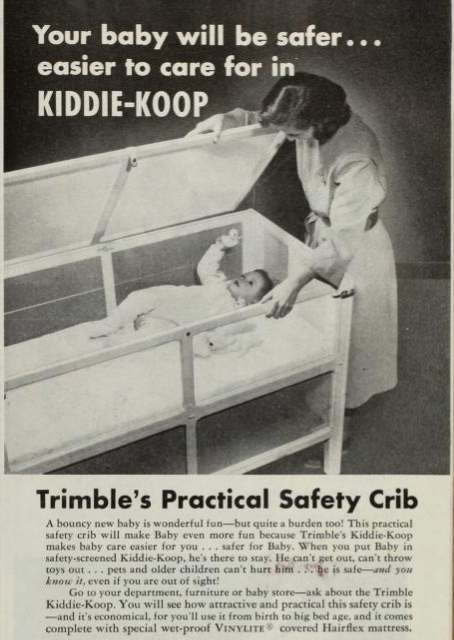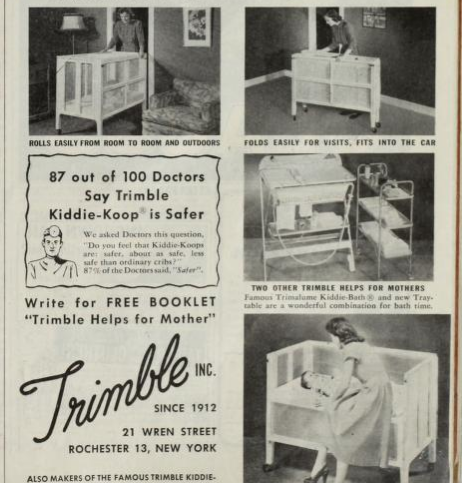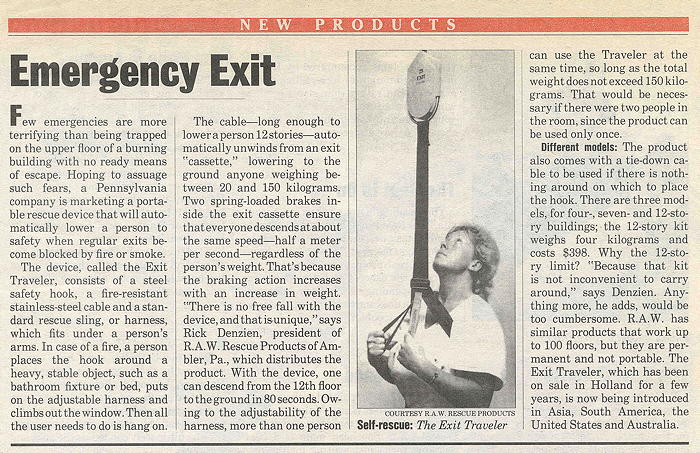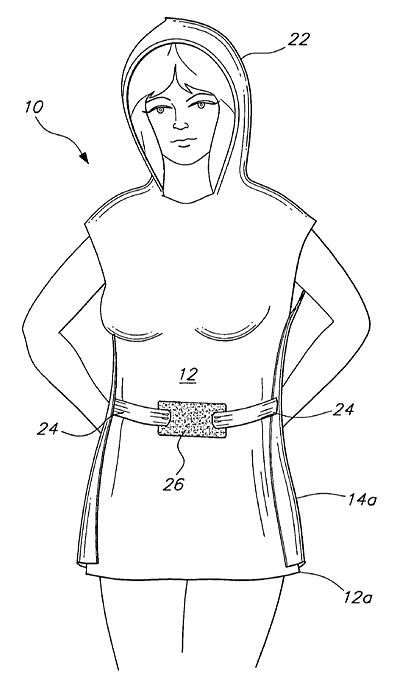Inventions
The Kiddie-Koop


Children in cages!
Source.
Posted By: Paul - Mon Apr 05, 2021 -
Comments (2)
Category: Babies, Domestic, Inventions, Chindogu, Advertising, 1950s
Fire-Breathing Woman
In April 1940, Linda Lancaster Dodge Stratton was granted a patent for the "cigar or cigarette lighter" shown below. Its novel feature was that it was shaped like a fire-breathing woman. Or, as Stratton put it, "in the shape of a human figure artistically posed with the igniting means located in the mouth and ignited and extinguished by the movement of the head to open and close the mouth thereof through the manual movement of the arms toward and from the mouth."It kinda looks like a fire-breathing Barbie. Though it predates Barbie by almost 20 years.
The patent said this woman was to be "constructed in a pocket or a table size." It would definitely be a conversation piece to have a table-size version of her in your home.


Posted By: Alex - Sun Apr 04, 2021 -
Comments (4)
Category: Inventions, Patents, Smoking and Tobacco, 1940s, Women
Combined Clothes Hanger and Radio
It's fairly common to use metal clothes hangers to extend the range of a radio's antenna. So John Jerome Spina had the idea of combining the radio and clothes hanger into one. The metal of the hanger would serve as the antenna. He was granted a patent for this invention in 1978.I'm not sure he thought through what would then happen if you hung something on the hanger, such as a coat.

Posted By: Alex - Sun Mar 28, 2021 -
Comments (1)
Category: Inventions, Patents, Radio, Technology, 1970s
Exit Traveler Rescue Kit
The Exit Traveler came on the market in the late 1980s. It was designed to let hotel guests rappel out of their window in the event of a fire.Of course, you had to carry the thing around in your luggage, on the off chance that you got stuck in a burning building and the stairs were inaccessible. Then you had to find something to anchor the device to. And it was one-use only. Perhaps why it never caught on.
Seems that the inventors also tried to get hotels to pre-install them in rooms, anchored to walls. But the hotels probably had visions of guests rappelling out of windows even when there wasn't a fire.
More info: Exit Traveler

Newsweek - Oct 26, 1987
Posted By: Alex - Sat Mar 20, 2021 -
Comments (4)
Category: Inventions, Hotels, 1980s
The Amplifier, or Enunciator
Robert Linn theorized that a loudspeaker shaped like a human head, containing a mouth and nose cavity similar to that of a person, would produce sounds that were of a higher quality and more "pleasing and properly modulated" than a regular loudspeaker would. So he created (and patented in 1927) what he called the Amplifier or Enunciator.
The resemblance to a sex doll has to be coincidental, because they weren't invented until after World War II. (The claim that Hitler invented the first sex doll is apparently a hoax).
Posted By: Alex - Sun Mar 14, 2021 -
Comments (2)
Category: Inventions, Patents, Music, 1920s
Breath Deflector
In case your bed partner has bad breath.Patented in 1922 by Darwin Comings of Scranton, Pennsylvania.

Posted By: Alex - Sun Mar 07, 2021 -
Comments (0)
Category: Furniture, Inventions, Patents, Sleep and Dreams, 1920s, Smells and Odors
Old Age Rejuvenator Centrifuge
It would probably work about as well as any other anti-aging treatment.More info: Modern Mechanix

Science and Mechanics - Aug 1935

Posted By: Alex - Tue Mar 02, 2021 -
Comments (3)
Category: Elderly and Seniors, Inventions, 1930s
Baitinger’s Automatic Eater
I posted last week about a 1940's invention which envisioned putting restaurant diners on a conveyor belt so that they could be carried past food stations. Several readers commented that the Japanese have embraced the opposite concept, of putting the food on a conveyor belt so that it travels past the diners.I did some research and discovered that the origin of the idea of having food on a conveyor belt traces all the way back to 1919 when John Moses Baitinger of Minnesota applied for a patent on this concept, which he called his "Automatic Eater". His patent was granted in 1923. He had small wooden cars, laden with food and drinks, moving along tracks, pulled by a system of cables.


Karal Ann Marling discusses some of the history of Baitinger's invention in her book Blue Ribbon: A Social and Pictorial History of the Minnesota State Fair:
The ensemble was the invention of the Reverend J.M. Baitinger, an Evangelic churchman, who stationed himself out in front with a megaphone to ballyhoo a new era in state fair dining: "Haba! Haba! Haba! This is the place to be merry. Eat! Eat! Eat! All you want for 50 cents; for without a full stomach you cannot enjoy the fair. Haba! Haba! Haba!"
The Automatic Eater cost Baitinger more than one thousand dollars to build but, because of its novelty and the economies it permitted, the cafe more than paid for itself during a trial run conducted on the last few days of the 1920 fair. "Through the medium of the Automatic Eater," he stated the following summer, "I do away with all excess help and employ only one cook, a dish washer, and a woman to keep the train well stocked with food. I pay no attention to what my customers eat, how long they stay or how much food they consume." But there were healthy profits, which Baitinger turned over to a St. Paul hospital.
Baitinger's Eater was, in many ways, a perfect expression of the mentality of the automation-mad 1920s, obsessed with speed, technology, and efficiency. There were minor drawbacks to the system, however. Diners seated near the end of the line sometimes found that the only cargo left for the eating was boiled cabbage.

Posted By: Alex - Sun Feb 28, 2021 -
Comments (2)
Category: Food, Inventions, Patents, Restaurants, 1910s
The Snore Consumer
I've come across reports in early 20th-century newspapers of an invention, designed to stop snoring, that worked by directing the sounds of the snoring into the snorer's own ear.
Oakland Tribune - Nov 26, 1933
I'm not sure if anyone ever really built this device, or if it was just a joke repeated by reporters.
The earliest report of it I've been able to find ran in newspapers in 1871. It attributed its invention to an unnamed woman from Iowa. However, I haven't been able to find a record of anything resembling this in the U.S. Patent Office, although there are numerous patents for anti-snoring devices.

Atchison Daily Champion - Feb 24, 1871
Posted By: Alex - Thu Feb 25, 2021 -
Comments (0)
Category: Inventions, Patents, Sleep and Dreams, Nineteenth Century, Cacophony, Dissonance, White Noise and Other Sonic Assaults
Bathing Poncho
The bathing poncho, invented by Timothy and Brenda Reardon, allows someone to shower while clothed. From the patent:In institutions such as hospitals, nursing homes, college dormitories, gyms, and the like, the bathing or showering facilities often lack the privacy to which one is accustomed to at home. Thus, becoming unclad to take a shower or a bath can be somewhat of an unpleasant and embarrassing experience. A covering that would preserve one's dignity by minimizing exposure while also insuring a thorough cleansing would certainly be a welcome addition in the marketplace.
I can appreciate the problem this addresses, but I wouldn't want to be the kid who shows up in the locker room shower wearing one of these.

Posted By: Alex - Sun Feb 07, 2021 -
Comments (3)
Category: Fashion, Hygiene, Baths, Showers and Other Cleansing Methods, Inventions, Patents

| Who We Are |
|---|
| Alex Boese Alex is the creator and curator of the Museum of Hoaxes. He's also the author of various weird, non-fiction, science-themed books such as Elephants on Acid and Psychedelic Apes. Paul Di Filippo Paul has been paid to put weird ideas into fictional form for over thirty years, in his career as a noted science fiction writer. He has recently begun blogging on many curious topics with three fellow writers at The Inferior 4+1. Contact Us |




